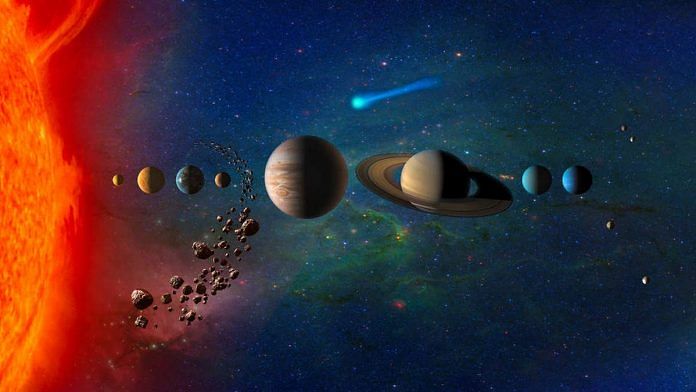Orbit of most distant object in the solar system mapped
Scientists in the US have mapped the orbit of a planetoid that is almost four times farther from the Sun than Pluto, making this the most distant known object in our solar system.
Dubbed Farfarout, the planetoid, was first detected in 2018. The team behind the finding has now collected enough observations to pin down its orbit.
Farfarout’s average distance from the Sun is 132 astronomical units (AU). One AU is the distance between the Earth and the Sun. Pluto is 39 AU from the Sun.
The object has an elongated orbit that takes it out to 175 AU at its most distant, and inside the orbit of Neptune, to around 27 AU, when it is close to the Sun.
Farfarout takes about 1,000 years to orbit the Sun, crossing Neptune’s orbit every time. It is likely that Farfarout experienced strong gravitational interactions with Neptune over the age of the solar system, which may explain why it has such a large and elongated orbit.
Farfarout is estimated to be about 400 km wide. The planetoid will be given an official name after its orbit is better determined over the next few years. Read more about it here.
Vapourised remnants of planets found in dying stars
A team has discovered remnants of planets with Earth-like crusts in the atmospheres of four nearby white dwarf stars. The discovery gives a glimpse into what planetary systems may have been like in the past.
The crusts are from the outer layers of rocky planets similar to Earth and Mars. The planets include one of the oldest planetary systems seen by astronomers so far.
The University of Warwick-led team was analysing data of over 1,000 nearby white dwarf from the European Space Agency’s Gaia telescope when they came across an unusual signal from one particular white dwarf.
The outer layers of the white dwarfs contain up to 3,00,000 gigatonnes of rocky debris, which includes up to 60 gigatonnes of lithium and 3,000 gigatonnes of potassium, equivalent to a 60km sphere of similar density to Earth’s crust.
The amount of crust material detected is similar in mass to that of the asteroids seen in our own solar system, leading the astronomers to believe that what they are seeing around the four stars is material broken off from a planet, rather than an entire planet itself. Read more here.
Also read: Mysterious diseases in chimpanzees at Sierra Leone sanctuary linked to bacteria
Hydrogen chloride discovered in Mars atmosphere
For the first time, hydrogen chloride has been detected in the atmosphere of Mars.
The discovery was made by the European Space Agency’s Roscosmos ExoMars Trace Gas Orbiter. The spacecraft has also offered new insights on how Mars is losing its water.
Hydrogen chloride (HCl) comprises a hydrogen and chlorine atom. Chlorine-based gases in cosmic bodies are of special interest to scientists because they are possible indicators of volcanic activity.
However, in this case, hydrogen chloride was detected at distant locations at the same time, and scientists did not find traces of other gases that are usually found during volcanic activity. This suggests that a different process may be taking place on Mars.
On Earth, salts in the form of sodium chloride — remnants of evaporated oceans — are lifted into the atmosphere by winds. Sunlight warms the atmosphere, causing dust, together with water vapour released from ice caps, to rise.
The salty dust reacts with atmospheric vapour to release chlorine, which then reacts with molecules containing hydrogen to create hydrogen chloride.
A similar process may also be taking place on Mars. Read more about this here.
Sawfish facing extinction due to overfishing
Scientists have warned that sawfish have disappeared from half of the world’s coastal waters. In fact, the distinctive shark-like rays are on the brink of extinction due to overfishing.
Sawfish, named after their unique long, narrow noses lined by teeth, called rostra, that resemble a sawblade, were once found along the coastlines of 90 countries. However, they are now among the world’s most threatened family of marine fish, presumed extinct from 46 nations.
The teeth on the rostra of sawfish are easily entangled in fishing nets. Sawfish fins are among the most valuable in the global shark fin trade and rostra are also sold for novelty, medicine and as spurs for cockfighting.
A team led by researchers at Simon Fraser University, Canada, recommends that international conservation efforts focus on eight countries — Cuba, Tanzania, Colombia, Madagascar, Panama, Brazil, Mexico and Sri Lanka — where conservation efforts and adequate fishing protections could save the species. Read more here.
Also read: Royal purple wool from 3,000 years ago gives a glimpse into King David & Solomon’s wardrobe
Whale songs help scientists study Earth’s crust
Scientists have found a way to use the songs of fin whales to map the oceanic crust.
Sound waves from fin whale are reflected and refracted within the Earth’s crust, including the sediment and the solid rock layers beneath.
Scientists from Oregon State University, US, have now found that the signals, recorded on seismometers on the ocean bottom, can be used to determine the thickness of the layers as well as other information relevant to seismic research.
The research could provide new avenues for using data from whale calls in research, expanding the use of data that is already being collected.
Using a series of whale songs that were recorded by three seismometers, the researchers were able to pinpoint the whale’s location and use vibrations from the songs to create images of the Earth’s crust layers. Read more here.
Also read: Fossils suggest world’s largest animal roamed the Earth 98 million years ago




ScientiFix ko Hindi me bhi karo na please
Yes. It must be shared in all languages of India.